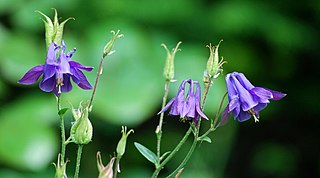
Aquilegia is a genus of about 130 species of perennial plants that are found in meadows, woodlands, and at higher elevations throughout the Northern Hemisphere, known for the spurred petals of their flowers.

Aquilegia formosa, the crimson columbine, western columbine, or (ambiguously) "red columbine", is a common wildflower native to western North America, from Alaska to Baja California, and eastward to Montana and Wyoming.

Aquilegia canadensis, the Canadian or Canada columbine, eastern red columbine, or wild columbine, is a species of flowering plant in the buttercup family Ranunculaceae. It is an herbaceous perennial native to woodland and rocky slopes in eastern North America, prized for its red and yellow flowers. It readily hybridizes with other species in the genus Aquilegia.

Aquilegia coerulea, the Colorado blue columbine, is a species of flowering plant in the buttercup family Ranunculaceae, native to the Rocky Mountains, USA. Aquilegia coerulea is the state flower of Colorado.

Cirsium arizonicum, the Arizona thistle, is a North American species of thistle in the family Asteraceae, native to the southwestern United States and northwestern Mexico. It has been found in Arizona, southeastern California, New Mexico, Nevada, Colorado, Utah, Sonora, and northwestern Chihuahua.
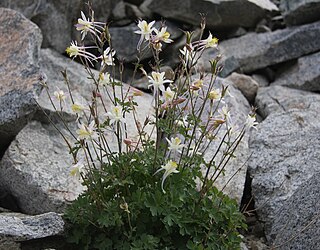
Aquilegia pubescens is a high-altitude species of columbine known by the common names Sierra columbine, alpine columbine and Coville's columbine. Its flowers are large and usually a creamy white.

Grayia is a genus of plants in the subfamily Chenopodioideae of the family Amaranthaceae. Common names are siltbush and hopsage. The four shrubby species occur in arid and semiarid regions of western North America:

Aquilegia saximontana, the Rocky Mountain columbine, alpine dwarf columbine, dwarf blue columbine, or alpine columbine, is a perennial plant that comes from the buttercup family, Ranunculaceae.

Sabulina nuttallii is a species of flowering plant in the family Caryophyllaceae known by the common names Nuttall's sandwort and brittle sandwort.
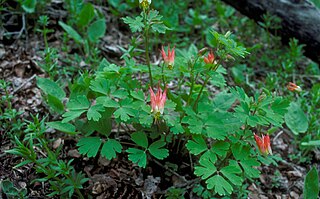
Aquilegia elegantula is a species of columbine known by the common name western red columbine. It is native to the southwestern United States, particularly the Four Corners states, and northern Mexico, where it grows in moist areas in mountain coniferous forests. It is a rhizomatous perennial herb growing 10 t 60 centimeters tall. The green leaf blades are borne on long, slender petioles and divided into three leaflets which each have rounded lobes along the front edges. The flower has five long petals up to 3 centimeters in length including their elongated, knob-tipped spurs. The petals are bright red in the spurs and lighten to yellow-green or orange at the tips. Between the petals are the oval-shaped sepals, which are reddish to yellowish in color and are held parallel to the petals. Flowers often droop such that the mouth is toward the ground and the spurs point up; the flowers are pollinated by the broad-tailed hummingbird.

Aquilegia micrantha var. grahamii is a variety of flowering plant in the buttercup family known by the common name Graham's columbine. It is endemic to Utah in the United States, where it is known only from Uintah County. It occurs in three canyons along the Uinta Mountains. There are an estimated 5,000 to 10,000 individuals.
Erigeron kachinensis is a species of flowering plant in the family Asteraceae known by the common names Kachina fleabane and Kachina daisy. It is native to Utah and Colorado in the United States. It is an endemic of the Colorado Plateau.

Aquilegia laramiensis is a species of flowering plant in the buttercup family known by the common name Laramie columbine. It is endemic to Wyoming in the United States, where it is known only from the Laramie Mountains.

Yucca angustissima, the narrowleaf yucca, is a plant in the family Agavaceae, known as the "narrow-leaved yucca." It is native to Arizona, New Mexico, Colorado and Utah, but grown elsewhere as an ornamental.

Allium geyeri or Geyer's onion is a North American species of onion widespread in the western United States and in western Canada. It is found in the Rocky Mountain States from New Mexico to Idaho, Great Basin, the Pacific Northwest, Texas, South Dakota, Arizona, Manitoba, British Columbia, Alberta and Saskatchewan.

Aquilegia barnebyi, commonly known as the oil shale columbine or Barneby's columbine, is a perennial species of flowering plant in the buttercup family, with a native range comprising northeastern Utah and northwestern Colorado in the United States. It is named after Rupert Charles Barneby, who, with Harry Dwight Dillon Ripley, first discovered it in Colorado.
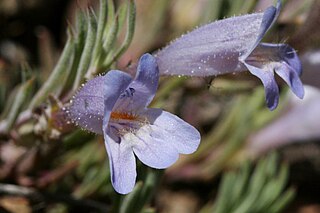
Penstemon caespitosus, commonly known as mat penstemon, is a summer blooming perennial flower in the large Penstemon genus. It is a widespread plant from near timberline to the foothills in the Southern Rocky Mountains and Colorado Plateau in North America. It is noted for its ground hugging growth habit and as a plant used in xeriscape and rock gardening.

Aquilegia sibirica, the Siberian columbine, is a species of flowering plant in the family Ranunculaceae native to the north-central Asian regions of Siberia, northern Mongolia, Kazakhstan, and Xinjiang. A hardy perennial plant, it prefers temperate environments. The Siberian columbine can be between 1 foot (0.30 m) and 2 feet (0.61 m) tall with flowers that are lilac-blue and white in color.

Aquilegia desolaticola, the desolation columbine, is a perennial species of plant in the family Ranunculaceae, endemic to Utah. It takes its name from its habitat, the remote Desolation Canyon on the Green River.
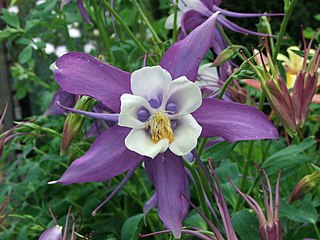
Aquilegia × hybrida is a hybrid species of columbine, the result of a cross between Aquilegia vulgaris and Aquilegia canadensis.




















